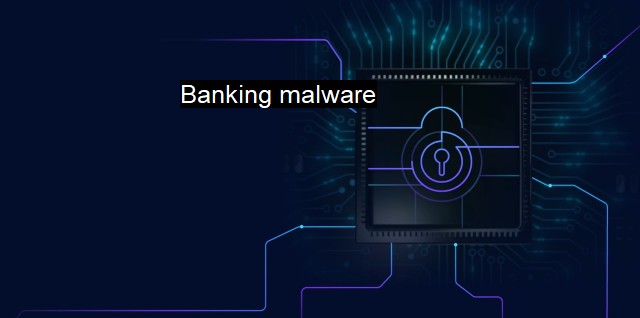What is Banking malware?
Uncovering the Secrets of Banking Malware: Stealing In Transit and Trick Tactics to Compromise Credentials
Banking malware is a special type of cyber threat designed specifically to steal sensitive banking and financial information like login credentials from various online banking platforms. This cybercrime strategy is one of the most sophisticated and expanding avenues of attack faced in the realm of cybersecurity.Banking malware operates by gaining unauthorized access to a victim's banking accounts via their electronic devices. This typically happens via two different kinds of attacks; those that mediate browser-client interaction to steal credentials, represented by platforms like SpyEye and Zeus, and those that tamper with transactions behind the scenes after a user's logged in, such as the sophisticated Carbanak malware that has managed to swindle several million dollars over the years.
When a bad actor propagates banking malware, the malicious software program infects a computer or network of computers, intercepting and stealing personal information and sensitive data that is stored or passing through the system. This can potentially involve login credentials, credit card numbers, bank account details, PINs, OTPs, and other significant financial data. It is sent back to the cybercriminals who use the information for personal gains, mostly through unauthorized transactions, selling the data to third-party enterprises, or planning large-scale frauds.
Cybercriminals have over time, refined their tactics for delivering banking malware, becoming increasingly sophisticated and evading detection. Techniques such as targeted phishing scams, water hole attacks (where a specific group's resources are compromised), malicious downloads or attachments, or even malvertising (malicious advertising) are typically used.
They often hide this banking malware in apps, files, or software programs that appear completely legitimate. cybercriminals may disguise malware as a typical software update, attach it to an email, or hide it within a seemingly harmless mobile application. After successfully infiltrating a device, it begins to monitor the victim's activity, typically looking out for connections to various online banking platforms.
Recent advancements in banking malware include multi-layer obfuscation and sophisticated evasion techniques which further complicate detection. These often include advanced features like rootkit functionality (hides presence by manipulating host functions), keystroke logging, advanced encryption techniques, app overlays, and remote control functionalities. For instance, the most sinister strains of banking malware are specialized Trojan viruses, like Ursnif, Dridex, and Qbot, which are capable of stealthy operations, including information harvesting, hidden within seemingly inconspicuous day-to-day operations.
In this sense, it's even more crucial for organizations and individuals alike to invest robustly in cybersecurity measures and turn to reliable antivirus platforms to protect their systems from attacks like these. Antivirus software can protect systems comprehensively by regularly scanning for, isolating, and removing banking malware. Firewalls and robust security protocols add additional layers of protection.
Keeping antivirus platforms and operating systems updated helps protect against new threats and banking malware variants. Users should refrain from opening suspicious emails or messages, clicking on links from unknown sources, or downloading unverified files or apps.
Banks and other organizations offering financial services are also grappling with the issue. Being custodians of their client's money, they have a responsibility to ensure secure transactions. Data encryption, multi-factor authentication protocols are increasingly being adopted to create strong defenses against banking malware.
In the rapidly shifting landscape of cybersecurity, education and awareness have also become key components in the strata of defense against banking malware. It's less likely for savvy users to be drawn into schemes minutely designed to exploit them.
Banking malware by design, aims to exploit vulnerabilities to steal a user's banking and financial data, and is one of the most significant threats to cybersecurity. As cyber attackers perpetually tweak their tactics, effective antivirus protection, robust cybersecurity measures, and consumer education are essential deterrent methods in the fight against this specific, unique, and continually evolving form of cybercrime.

Banking malware FAQs
What is banking malware?
Banking malware is a type of malicious software or malware designed to steal financial information, login credentials and other sensitive data from users of online banking and payment systems.How does banking malware spread?
Banking malware can spread through spam emails, infected attachments, malicious websites, social engineering attacks, and software vulnerabilities.What are the risks and consequences of banking malware?
The risks and consequences of banking malware include financial loss, identity theft, loss of sensitive data, and damage to the reputation of individuals and organizations.How can individuals and organizations protect themselves from banking malware?
Individuals and organizations can protect themselves from banking malware by using up-to-date antivirus software, operating systems, and browsers, avoiding suspicious emails, links, attachments, and websites, and using strong and unique passwords. It's also important to keep backups of important data, and regularly monitor financial statements and bank accounts for any unusual activity.| | A | | | B | | | C | | | D | | | E | | | F | | | G | | | H | | | I | | | J | | | K | | | L | | | M | |
| | N | | | O | | | P | | | Q | | | R | | | S | | | T | | | U | | | V | | | W | | | X | | | Y | | | Z | |
| | 1 | | | 2 | | | 3 | | | 4 | | | 7 | | | 8 | | |||||||